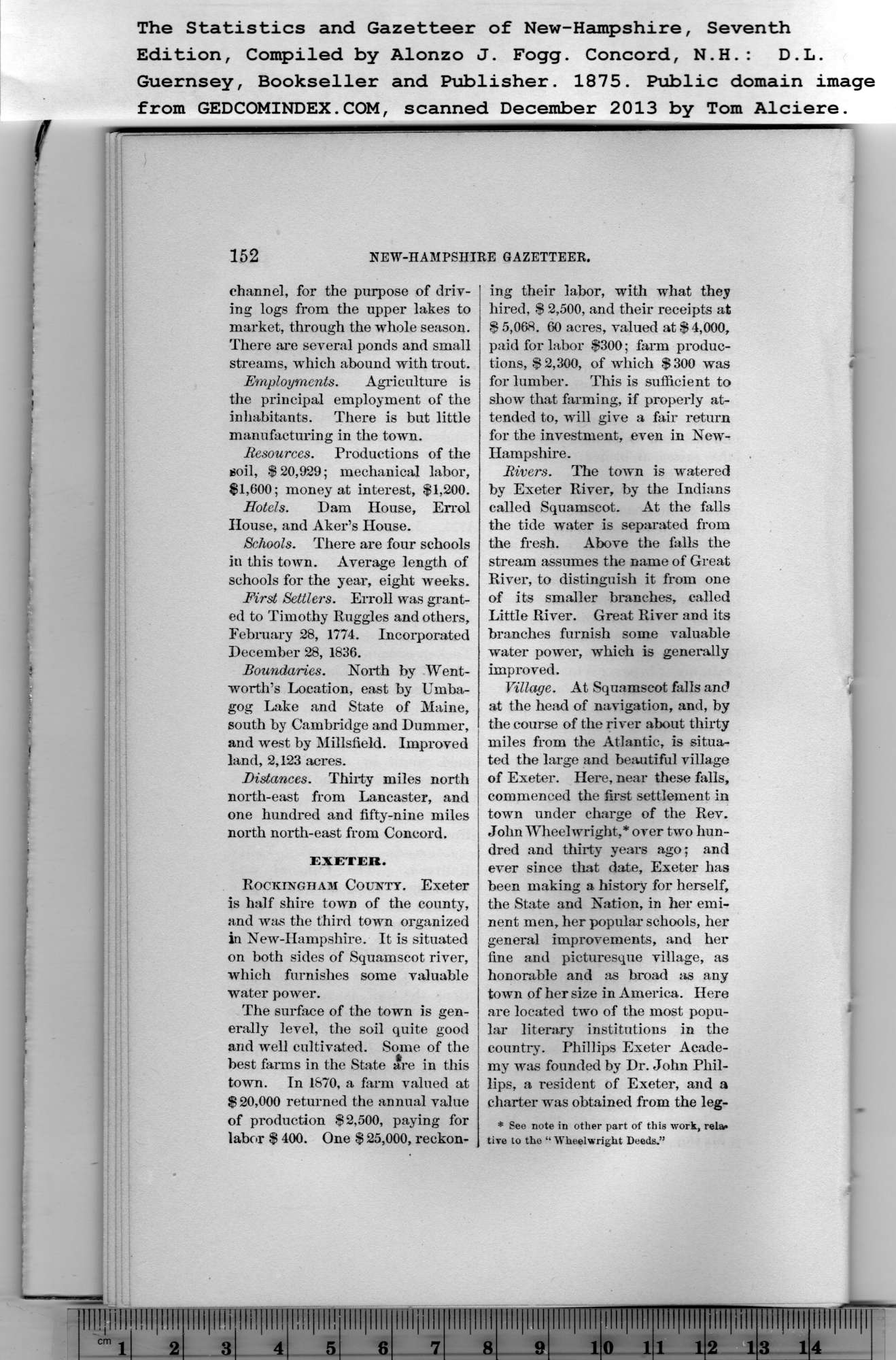|
152
The Statistics and Gazetteer of New-Hampshire, Seventh
Edition, Compiled by Alonzo J. Fogg. Concord, N.H.: D.L.
channel, for the purpose of driv-
ing logs from the upper lakes to
market, through the whole season.
There are several ponds and small
streams, which abound with trout.
Employments. Agriculture is
the principal employment of the
inhabitants. There is but little
manufacturing in the town.
Resources. Productions of the
soil, $ 20,929; mechanical labor,
$1,600; money at interest, $1,200.
Hotels. Dam House, Errol
House, and Aker’s House.
Schools. There are four schools
in this town. Average length of
schools for the year, eight weeks.
First Settlers. Enroll was grant-
ed to Timothy Ruggles and others,
February 28, 1774. Incorporated
December 28, 1836.
Boundaries. North by Went-
worth’s Location, east by Urnba-
gog Lake and State of Maine,
south by Cambridge and Dummer,
and west by Millsfield. Improved
land, 2,123 acres.
Histances. Thirty miles north
north-east from Lancaster, and
one hundred and fifty-nine miles
north north-east from Concord.
EXETEK.
Rockingham County. Exeter
is half shire town of the county,
and was the third town organized
in New-Hampshire. It is situated
on both sides of Squamseot river,
which furnishes some valuable
water power. |
The surface of the town is gen-
erally level, the soil quite good
and well cultivated. Some of the
best farms in the State are in this
town. In 1870, a farm valued at
$ 20,000 returned the annual value
of production $2,500, paying for
labor $ 400. One $ 25,000, reckon-
ing their labor, with what they
hired, $ 2,500, and their receipts at
$ 5,068. 60 acres, valued at $4,000,
paid for labor $300; farm produc-
tions, $2,300, of which $300 was
for lumber. This is sufficient to
show that farming, if properly at-
tended to, will give a fair return
for the investment, even in New-
Hampshire.
Rivers. The town is watered
by Exeter River, by the Indians
called Squamseot. At the falls
the tide water is separated from
the fresh. Above the falls the
stream assumes the name of Great
River, to distinguish it from one
of its smaller branches, called
Little River. Great River and its
branches furnish some valuable
water power, which is generally
improved.
Village. At Squamseot falls and
at the head of navigation, and, by
the course of the river about thirty
miles from the Atlantic, is situa-
ted the large and beautiful village
of Exeter. Here, near these falls,
commenced the first settlement in
town under charge of the Rev.
John Wheelwright,* over two hun-
dred and thirty years ago; and
ever since that date, Exeter has
been making a history for herself,
the State and Nation, in her emi-
nent men, her popular schools, her
general improvements, and her
fine and picturesque village, as
honorable and as broad as any
town of her size in America. Here
are located two of the most popu-
lar literary institutions in the
country. Phillips Exeter Acade-
my was founded by Dr. John Phil-
lips, a resident of Exeter, and a
charter was obtained from the leg-
* See note in other part of this work, rela*
tive to the “ Wheelwright Deeds.” |
